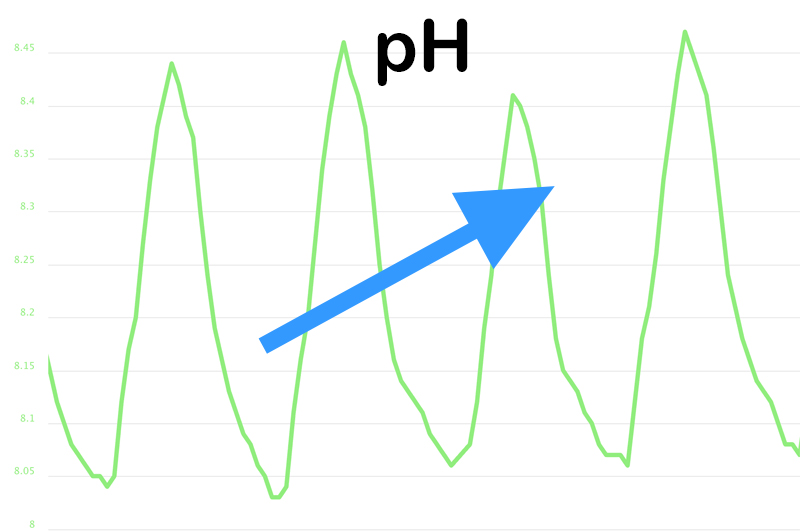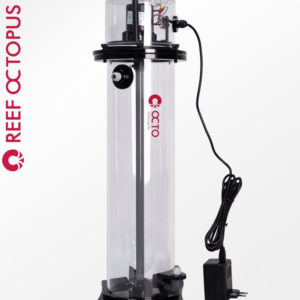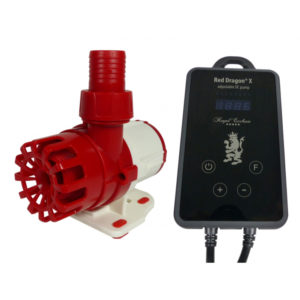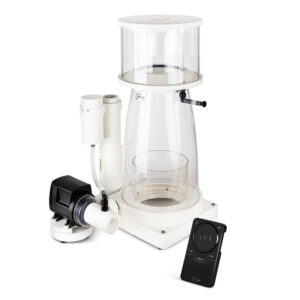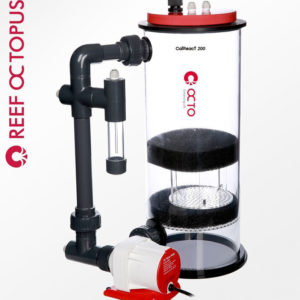An acceptable pH for a reef tank is between 7.8 and 8.5. However, I have found my SPS corals do better when pH is in the 8.1 to 8.5 range.
There are several reasons why pH might be chronically low (7.7 to 7.9) in an aquarium. The tank could be in a room with poor air ventilation, causing C02 in the space to build up and lower the pH (C02 in the room is dissolved into the tank’s water).
Carbon dioxide impacts pH because it rapidly turns into carbonic acid when it enters the water. Acids lower pH, so more carbon dioxide means more carbonic acid, which means lower pH1.
A calcium reactor can also lower a tank’s pH since C02 is injected into the reactor. The C02 helps to dissolve the calcium-based media inside the reactor. This calcium-rich liquid or effluent is then dripped back into the tank.

Having trouble boosting pH? Here are 5 tips to raise pH in a reef tank.
#1 Add More Fresh Air from Outside
If you have a high concentration of C02 in the room with the tank then bringing in more fresh air from outside will certainly help. Step one is to obtain a carbon dioxide meter to check the amount of C02 present. Any reading over 1000 ppm could indicate a potential problem with air circulation and fresh air in a room.
A simple solution is to open up some windows, although this is not an option during the winter in colder climates. I fall into this category since I live in Vermont. I opted to have an air exchange unit installed. This was not a cheap alternative but it proved to be very effective. The addition of the air exchange unit increased my pH by .2. This is significant since pH is measured on a logarithmic scale.
Another thing to try is to pull air from the outside and direct it into the skimmer. Airline tubing can be run from the outside to the air intake on a skimmer. I did try this at one point but it did not work. My hose was 30 feet so perhaps it was too long of a run.
#2 Use Kalkwasser
A common way to raise pH, especially if you use a calcium reactor, is to use kalkwasser. Hydroxide ions in the kalkwasser use carbon dioxide to increase alkalinity and, as a result, removes excess C02 and increases pH.
In the past I have used a kalk reactor to dose kalkwasser. Kalk reactors are typically fed by RO/DI water used to replace evaporated water in a tank. The problem here is the amount of kalk added to the tank can vary depending on the evaporation rate in the tank. This can cause the alkalinity to swing, not a good thing. If you use a kalk reactor then make sure it is not connected to an auto top-off device.
One last thing to note about kalk reactors is kalkwasser can be less potent given the constant influx of RO/DI water, which can dilute the solution.
Today I keep kalkwasser in a thirty gallon drum filled with RO/DI water. 3,600 mls of this saturated solution is dosed daily to my 300 gallon system via two peristaltic dosing pumps. I use two other pumps to dose 2,400 mls daily to my 225 gallon peninsula tank.

The dosing occurs when the display tank lights are off to compensate for the lower pH during this time. I do not stir the solution. The only time it is mixed is when the drum is refilled every two weeks with RO/DI water and kalkwasser. Every two months I replace the kalkwasser that has settled in the drum.
A key with this method is to make sure to add enough kalkwasser to super saturate the solution. The way I determine this is by measuring the conductivity of the mixture. Saturated solutions have a conductivity around 10.3 mS/cm at 25 deg C2.
#3 Drip Ca Reactor Effluent Into Skimmer Pump
Dripping the effluent from a calcium reactor into the pump feeding the protein skimmer can raise pH. The C02 in the effluent is degassed since there is a lot of gas exchange that occurs inside a skimmer.
#4 Run a C02 Scrubber
A C02 scrubber has C02 absorbing media inside that can raise pH. These units are attached to the air intake of a skimmer and will remove C02 before it enters the skimmer.
#5 Use Macro Algae
Using macro algae via a refugium, algae scrubber or algae reactor will raise a tank’s pH since algae absorbs C02. The pH of a reef tank is lower when the display tank lights are off so it is best to run lights for macro on a reverse light cycle. Utilizing plant life above water can help as well. House plants absorb C02 in the air so having a bunch in a room with a reef tank can raise a tank’s pH.
#6 (Bonus) Consider a Dual Chamber Calcium Reactor
If you are set on using a calcium reactor then consider a dual chamber versus single chamber reactor. The second chamber contains additional media that can help absorb excess C02. I have both a dual chamber reactor and a single chamber reactor and the ph for the system with the dual chamber reactor tends to run higher.
Additional Resources
If you would like some help with a new tank build, including help designing a custom aquarium, or help re-configuring your current setup then you can visit this page for more information. And if you are looking to add some equipment, I do sell GHL, Pax Bellum, Reef Octopus Calcium and Kalk Reactors and Royal Exclusiv products, including Dreamboxes, which is the equipment I use and recommend. I also sell Reef Brite metal halide and LED fixtures as well as Maxspect & IceCap Gyres.
As for additional insights and information, please explore my many other reef tank and SPS related articles as well as my YouTube channel. For an even deeper dive into reef tank care you can check out my Reef Keeping Master Class. This online course is an immersive and one of a kind educational tool designed to help reef aquarium hobbyists build and maintain a beautiful SPS reef tank. The course is a series of video presentations with some supplemental video from my YouTube channel. There are also quizzes to help students retain and understand the information presented in the course.
Need some frags…..I can help with that as well 🙂 Please visit my SPS Frag store to see what is available.
1 Reef2Reef, pH and the Reef Aquarium, Randy Holmes-Farley
2 Reefkeeping Magazine, What Your Grandmother Never Told You About Lime, Randy Holmes-Farley

